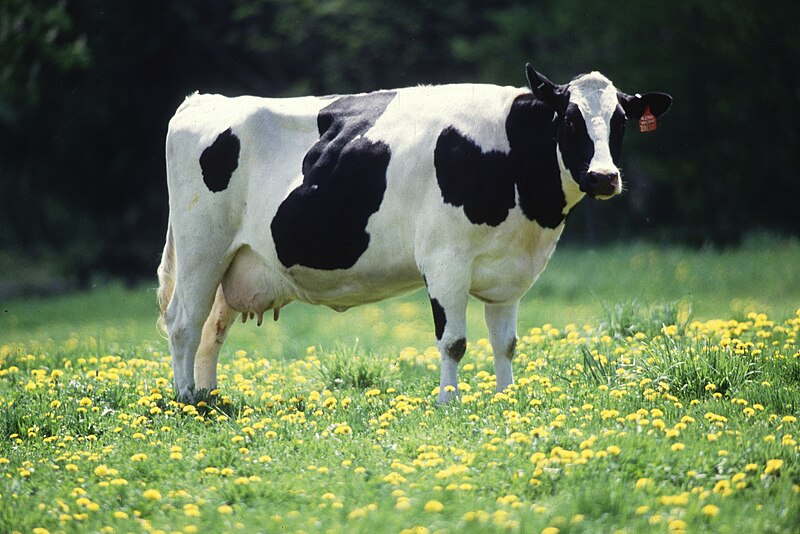Lahabali kɔligu:Cow female black white.jpg

Jɔhiyuli maa galisim:800 × 534 anfooni bihi bihi. Din pahi resolutions: 320 × 214 anfooni bihi bihi | 640 × 427 anfooni bihi bihi | 1,024 × 684 anfooni bihi bihi | 1,280 × 855 anfooni bihi bihi | 2,700 × 1,803 anfooni bihi bihi.
Faal maa maŋmaŋa (2,700 × 1,803 pixels, file size: 887 KB, MIME type: image/jpeg)
Faal tarihi
Dihimi dabisili/saha n-nya kɔl' bihi kamani di ni di yina shɛm
| Zuŋɔ dabisili/Saha | Thumbnail | Di tarisi | ŋun su | tɔhibu | |
|---|---|---|---|---|---|
| din na chana | 03:31, 29 Silimin gɔli August 2023 |  | 2,700 × 1,803 (887 KB) | ReichLover1997 | Reverted to version as of 21:09, 24 May 2006 (UTC) |
| 00:42, 1 Silimin gɔli September 2018 |  | 2,190 × 1,680 (725 KB) | Hohum | Cropped, colour adjust | |
| 21:09, 24 Silimin gɔli May 2006 |  | 2,700 × 1,803 (887 KB) | Siebrand | {{Information| |Description= {{nl|Een koe}} {{en|Because much of the cost of a cow is the feed and labor needed to maintain her, fewer but higher yielding cows mean lower priced milk. Dairy herd improvement ultimately benefits consumers. That's why it's j |
Lahibali kɔligu zaŋ tum tuma
Din doli ŋɔ na yaɣili tuma nima zaŋ ti lahabali kɔligu ŋɔ:
Duniya zaa lahabali kɔligu zaŋ tum tuma
Wikis shɛŋa ŋan dolina ŋɔ gba malila faal ŋɔ n kuri bukaata:
- Zaŋ tum tuma ace.wikipedia.org zuɣuc
- Zaŋ tum tuma ang.wikipedia.org zuɣuc
- Zaŋ tum tuma an.wikipedia.org zuɣuc
- Zaŋ tum tuma ar.wikipedia.org zuɣuc
- Zaŋ tum tuma ast.wikipedia.org zuɣuc
- Zaŋ tum tuma ast.wiktionary.org zuɣuc
- Zaŋ tum tuma az.wiktionary.org zuɣuc
- Zaŋ tum tuma ba.wikibooks.org zuɣuc
- Zaŋ tum tuma be.wikipedia.org zuɣuc
- Zaŋ tum tuma bg.wikipedia.org zuɣuc
- Zaŋ tum tuma bjn.wikipedia.org zuɣuc
- Zaŋ tum tuma bn.wikipedia.org zuɣuc
- Zaŋ tum tuma bn.wikibooks.org zuɣuc
- Zaŋ tum tuma bs.wiktionary.org zuɣuc
- Zaŋ tum tuma ca.wikipedia.org zuɣuc
- Zaŋ tum tuma ca.wikibooks.org zuɣuc
- Zaŋ tum tuma ca.wikiquote.org zuɣuc
- Zaŋ tum tuma ca.wiktionary.org zuɣuc
- Zaŋ tum tuma ceb.wikipedia.org zuɣuc
- Zaŋ tum tuma chr.wikipedia.org zuɣuc
- Zaŋ tum tuma ckb.wikipedia.org zuɣuc
- Zaŋ tum tuma csb.wiktionary.org zuɣuc
- Zaŋ tum tuma cy.wikipedia.org zuɣuc
- Zaŋ tum tuma da.wikipedia.org zuɣuc
- Zaŋ tum tuma da.wiktionary.org zuɣuc
- Zaŋ tum tuma de.wikipedia.org zuɣuc
- Zaŋ tum tuma de.wiktionary.org zuɣuc
- Zaŋ tum tuma ee.wikipedia.org zuɣuc
Yulima more global usage zaŋ chaŋ lahabali kɔligu ŋɔ.